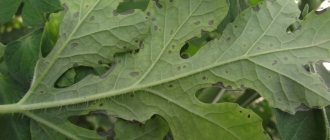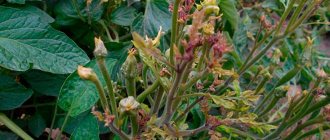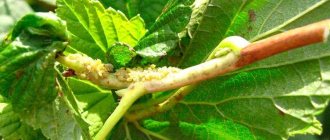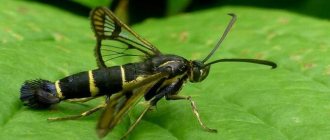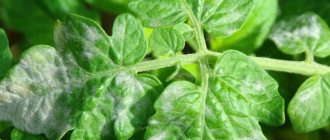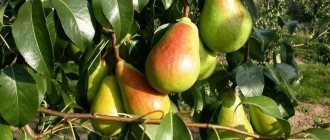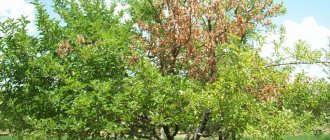How to detect tomato cutworm in time
A careful inspection of the tomato bed will reveal signs of damage. The vegetable grower will not be able to see the butterfly itself. But the caterpillar feeds and traces of its “dinners” can be found. To do this you should inspect:
- leaves, especially the lower ones;
- shoots;
- buds;
- flowers.
Unfortunately, the vegetable grower becomes aware of the presence of cutworms on the plot only when he sees huge holes in the tomatoes. Sometimes you can see a caterpillar in them. Having made a hole, she decides not to leave, but to rest where she had eaten.
Preventive measures
Following simple rules will help avoid pest invasion. To do this you need:
- regularly inspect leaves and stems;
Cutworm caterpillar on tomatoes.
- remove weeds;
- digging up the soil in autumn and spring helps destroy pupae;
- plant calendula, basil, cilantro - they cannot stand the smell;
- remove plants and fruits that have been damaged by caterpillars.
Reasons for appearance
Sometimes a vegetable grower does not even suspect that there are cutworms on his plot. Pre-winter plowing and severe frosts regulate the pest population. Those that survive do not do much harm, except for a few eaten tomatoes.
The situation is different in the southern regions. The armyworm population is growing from year to year and it is becoming more and more difficult to fight. This is possible for the following reasons:
- Lack of autumn farming culture. If it is not customary to plow the soil in the fall or dig up the garden, the pupa becomes inaccessible to frost.
- Not thoroughly removing weeds and plant debris after harvesting the garden.
- A huge number of weeds in the garden or neighbors' plots. In this case, she has every chance of remaining unnoticed and continuing to reproduce.
Attention! If frost helps northerners, then southerners should clean their gardens more carefully.
Where does the cutworm come from on tomatoes?
In greenhouses, greenhouses and vegetable gardens, cutworm pupae and caterpillars overwinter in the ground. Suitable conditions in cold climates are created by plant residues that have not been harvested since autumn, warming the soil. Sometimes the armyworm enters the site along with purchased soil, “enriched” with the pest overwintering there.
Coming to the surface, the pest begins to feed on weeds. By the time crops are sown or planted, the cutworm is usually ready to lay eggs.
It is impossible to completely prevent its occurrence even by annual deep digging and disinfection of the soil in the fall. The armyworm flies well and can move from a neighboring area or migrate from afar.
Some species are capable of covering vast distances with air currents. In the Far East you can sometimes even find tropical cutworms. But they do not overwinter there and die at the end of the season.
Signs of defeat
The cutworm butterfly can only be seen at night. But its presence in a tomato plot is not difficult to notice:
- If you look closely at the underside of tomato leaves, you can see eggs. If there are not many insects, then searching for oviposition may be difficult;
- the lower leaves on the tomato bushes, and then the upper ones, become scabbed. The caterpillar eats away the soft tissue of the leaf blade, but the vein remains. So she moves from the lower leaf to the upper one, leaving behind the skeletons of the leaves;
- You can catch the caterpillar eating and examine it late in the evening, when it has already climbed up the shoot to the leaf;
- if there are a lot of insects, then the tomato plantings look gloomy: the leaves and buds are worn out, the fruits are holed. Further, the caterpillar becomes more and more voracious and the tomatoes become covered with eaten holes;
- the gnawed leaf begins to turn black and dry out;
- large brown tomatoes are trying to heal, but they have little success. The process of decay begins.
Folk methods of struggle
Decoction recipes
- Wormwood . Soak 1 kg of fresh parts of the plant (stems and leaves can be used) in 3 liters of water and boil for 15-20 minutes. This decoction is completely harmless to people, so it can be used often.
- Tomato tops . Acts against cabbage cutworm and its larvae. For 10 liters of water take about 3.5 - 4 kg of fresh raw materials. Cook for 25-30 minutes, filter and dilute with water in a ratio of 1:3.
- Red or black elderberry . Flowers and leaves (300-400 g) must be boiled in a bucket of water for half an hour. Add liquid soap to the working solution - 40-50 grams.
- Peppermint (water pepper) is a very effective means of killing caterpillars. Use fresh plants cut in June or July. A bucket of water requires 1 kg of raw materials. After boiling for 30 minutes, the broth must be cooled and filtered.
- Bitter red pepper . You can use both dry (500 g) and fresh (1 kg) raw materials. It must be boiled in 10 liters of water for about an hour. The decoction must steep for at least 24 hours. Before processing, it is diluted in cold water in a ratio of 1 part decoction to 7-8 parts water.
- Sarepta mustard . Dry powder (50 g) must be boiled in a liter of water and left to cool for a while. Close tightly and leave for at least a day. Dilute this volume with cold water in an amount of 20 liters. The decoction is used for spraying affected plants and treating planting material.
Infusion recipes
- Large burdock (burdock) . Finely chop the leaves and stems and place them in a bucket, filling it to the middle, adding water to the brim. Cover and leave for 2-3 days. To improve adhesion, you can add liquid soap - 40-50 grams.
- Large-flowered delphinium . Grind the inflorescences (100 g) and leave for 2 days in a liter of water under a closed lid.
- Onions or green onions . A quarter of an average onion is required per liter of water. It is better to grind it, leave it to infuse overnight (10-12 hours), filter it and use it to treat plants. If you feel sorry for the onion, you can use the peel (7-8 g per liter).
- Garlic . Infuse a couple of cloves in a liter of warm water for 3-4 days. For spraying, dilute the infusion with 5 parts of water.
- Black henbane . This plant becomes most effective during the flowering period. At this time, cut off the above-ground part, chop it and fill it with water - 10 liters per 1 kg of raw materials. Leave for 11-13 hours.
Read on to learn how to treat tomatoes against cutworms.
Other recipes
- Wood ash, lime and tobacco powder . The components are mixed in equal quantities and the affected plants are pollinated. Used against cutworm caterpillars.
- Liquid soap and wood ash . Pour 2 cups of ash and 1-2 dessert spoons of any soap into a bucket of cold water. Used for spraying plants.
- Potassium permanganate . Treating plants with a manganese solution has a triple benefit - it works as a means of combating cutworms, as a fertilizer and as a disinfectant that kills bacteria and viruses. To spray bushes and young seedlings, make a glass of a strong dark solution of potassium permanganate and pour it into a bucket of water, stir very well.
- Potassium chloride and superphosphate . Also helps against aphids. 5 g of potassium and 10 g of superphosphate are diluted in a bucket of water. The mixture is infused for about a day, used several times with an interval of 8-9 days, up to 3 times per season.
- Kerosene . 700-850 ml of kerosene and 350-450 g of soap (preferably laundry soap, but any other is possible). Dissolve the soap in a liter of hot water, carefully pour kerosene into it in a small stream and add another 9 liters of water. Stir all this and use immediately to treat plants.
Double effect - destruction of cutworm caterpillars and potassium-phosphorus fertilizer.
Life cycle
Depending on the species and area of distribution, the life cycle differs slightly in time, but is basically as follows:
- a butterfly that lays eggs on a leaf plate at night;
- they mature and after some time the larva, the caterpillar, hatches;
- young caterpillars feed on the leaf and, as they grow, move away from each other in search of food;
- During the growth period, they molt and, having reached maturity, fall to the ground to pupate. By secreting sticky substances and sticking dust to itself, the cocoon becomes the same as that of other butterflies. It can lie on the ground or be slightly buried 2-4 cm in the ground. The growth of the pupa lasts from 3 to 30 days;
- After some time in the summer, a butterfly flies out of the pupa. If it is deep autumn, the pupa overwinters in the ground;
- The emerging butterfly still needs food for the maturation of reproductive products. For several days she feeds on pollen, then mates;
- Now she again lays eggs on the bottom of the leaf.
The life cycle of the cutworm in northern latitudes is interrupted by cold and frost. In the southern regions it is continuous.
Types of cutworms dangerous for tomatoes
Cutworms (Noctuidae) or noctules are one of the largest families of lepidopteran insects. According to the latest data, it includes more than 1,000 genera and about 12,000 species. Information that the family contains 36,000 species is outdated. Noctuid moths are excluded. There are 24,000 species in a separate family, Erebidae.
Noctuids are distributed throughout the globe - from the Arctic to Africa. More than 1,500 species can be found in Russia.
Cutworms are medium-sized butterflies with a round head and two pairs of wings. They fold along the body in a horizontal plane, are distinguished by their triangular shape and faded colors.
The front wings are decorated with a characteristic cutworm pattern consisting of three fields called bands. The spots are not randomly located, but form a system; three of them are usually called the main ones and are described when defining the taxon: round, wedge-shaped and kidney-shaped. The pattern is clearly visible in the photo. In different scoops, it allows for deviations and variations that do not fit into the general scheme.
The pest's lifestyle is predominantly evening and nocturnal. For plants, including tomatoes, it is not butterflies that pose a danger, but caterpillars. They go through several molts and have 5-6 instars.
When they are at different stages of development, the harmfulness of the caterpillars changes. Pupation occurs in the ground, at a depth of 5-7 cm, in some species in spring and summer - on leaves and stems.
Most cutworms are polyphagous, meaning they can feed on different crops. Some species are recognized as dangerous quarantine pests. It is with them that gardeners are forced to fight for the harvest. The only good thing is that the measures to combat the fall armyworm on tomatoes are the same, regardless of the type.
Cotton bollworm
Helicoverpa armigera is a polyphagous pest. It is an inconspicuous butterfly with a wingspan of 3-4 cm in the front wings, bordered by a brown stripe. Their main color is gray-yellow, with reddish, green and pinkish impurities. In the center is a dark mark that looks like a sickle. Round and kidney-shaped spots are gray, decorated with fuzzy transverse lines.
Caterpillars 3.5-4 cm long are covered with small growths, called spines in biology, and are distinguished by three dark longitudinal stripes on top and one yellow stripe on the bottom. The color of the body is variable, it can be:
- white;
- yellow;
- brown;
- green;
- black.
In Russia, the bollworm feeds on tomatoes and 120 other plant species. In the first period, the caterpillar gnaws on leaves, then moves into the stems and eats tomatoes.
The temperature favorable for the development of the pest is from 22 to 28° C, the minimum is 18° C. Fertility is 300-2700 eggs. In the middle zone, 1 generation manages to appear, in the south - 2-3. The complete development cycle from egg to mature butterfly depends on temperature and usually lasts 30-35 days. Of these, 13-22 are larvae (caterpillars).
It is believed that cutworms on tomatoes begin to pose a problem if their number exceeds 10-12 larvae or 20 eggs per 100 bushes. This indicator is usually called the threshold of harmfulness. The pupae overwinter.
Scoop Gamma
Phytometra gumma is distributed throughout the European part of Russia: in the Caucasus, Far East, Central Asia and Western Siberia. It affects 100 species of cultivated plants, including tomatoes.
Wingspan – 4-4.8 cm. Color – from gray to brown, with a purple tint. The name is derived from the marking, shaped like the Greek letter γ (gamma), silvery in color, located on the front pair of wings. The kidney-shaped and round spots are bordered.
Caterpillars that parasitize tomatoes are green, with two fuzzy, sinuous white stripes on their backs. Spiracles are yellow. Length 2.4-4 cm.
The gamma cutworm differs from other species by black spots on the sides of its head.
The larva goes through 5 instars. At the initial stages it requires high humidity (90-100%). It belongs to the leaf-eating type - it eats the plates of tomatoes and other crops, leaving only large veins. Then it becomes able to gnaw through the flowers and fruits of tomatoes.
The optimal temperature for life is 20-25° C, the minimum is 17° C. The full development cycle is 25-45 days, of which 16-25 are at the larval stage, when the caterpillars actively eat tomatoes. In the north it gives 1 generation, in the southern regions - 3, sometimes 4.
In summer it pupates on the tops or under the leaves of plants. With the onset of cold weather - in the ground. Not only pupae, which can withstand temperatures down to -18° C, overwinter, but also butterflies and caterpillars.
exclamation scoop
Agrotis exclamationis is a gnawing cutworm, a broad polyphagous species. It lives throughout the European part up to the Arctic Circle. Found in the Far East, the Caucasus, Kamchatka, and Siberia. It affects 75 plant species, including tomatoes. In the North it produces 1 generation, in the southern regions - 2.
A butterfly with a wingspan of 3.2-4.5 mm. Color ranges from gray with a yellow tint to brown. Spots:
- kidney-shaped – black-brown;
- round – a little lighter;
- wedge-shaped is a narrow black stripe.
The caterpillars are grayish-brown or faded yellow, 3.3-5 cm long, covered with pimples. The head is red. Damages tomato stems at ground level. Adult caterpillars overwinter and can withstand low temperatures well even in the North. In the spring they eat off and only then pupate.
Fall armyworm
Agrotis segetum is a cutting armyworm, a polyphagous pest of tomatoes and 150 other crops. The range in Russia covers the entire European part, Southern Siberia, Transcaucasia, and the Far East. In the North, only 1 generation develops, as you move south - up to 4. Favorable temperature - from 16 to 30 ° C, minimum - 10 ° C.
The wingspan is 3-4.6 cm. The color of the front wings is rarely purely gray, usually with an admixture of brown. The transverse stripes are clear. Spots:
- wedge-shaped - small, gray, with a black outline;
- round - in the shape of a disk or oval, light, with a thin charcoal border;
- kidney-shaped with regular outlines, large, dark gray in the middle, much lighter on the periphery, with black edging.
Caterpillars are 4-5 cm long, brown-gray, glossy. The head is red, there are small pimples and dark longitudinal stripes on the body.
At the 1st-2nd stage of development, the larvae of the winter cutworm usually feed on weeds, since they are characterized by an early appearance - the cultivated plants have not yet been planted. They can damage seeds and eat up seedlings of early varieties of tomatoes, other vegetables and herbs.
Caterpillars, starting from the third instar, rise higher and gnaw leaves, leaving only large veins. The fruits, including tomatoes, are not touched. The caterpillars feed on leaves until October, then burrow into the ground to a depth of 10 to 25 cm.
The full development cycle is usually 50-70 days. The duration of the larval (caterpillar) stage depends on temperature and region, lasting from 24 to 36 days. In the North, winter cutworms travel from the ovipositor to the adult individual over a much longer period of time. Sometimes the caterpillar stage there lasts up to 100 days.
Adult larvae overwinter and can withstand -11, and at low humidity -18° C. Young caterpillars in the south survive at -5° C.
Cutworm
Lacanobia oleracea, synonym – Lettuce armyworm, is a polyphagous pest of agricultural crops that also affects tomatoes. Distribution in Russia - the entire European part, the Caucasus, Transcaucasia, Siberia, the Urals, the Far East.
The wingspan is 3.3-4.2 cm, the color is brown with a reddish tint. Spots: kidney-shaped - orange or yellow, round - dark, both surrounded by a white rim. Fertility – 400-1500 eggs.
The caterpillars are covered with spots: small light and large black, bristly. Body color can be green, brown with a yellow or red tint. The head and spiracles are yellow.
They damage the leaves of ornamental and agricultural plants, including tomatoes.
If representatives of the Chenopodiaceae or Asteraceae families grow near the beds or greenhouses, the garden cutworm will pay attention primarily to them. And then he will move to the garden.
The pest lives in the larval stage for 30-40 days. The pupae overwinter in the ground. In the North, 1 generation develops, in warm climates - 2.
Scoop Karadrina
Spodoptera exigua has a second name - tomato cutworm. A polyphagous pest, its food list includes 185 crops, including tomatoes. In Russia, the species' range extends across southern Siberia and Europe. The pest is found in the Trans-Urals, Transcaucasia, and the Far East.
Butterflies are brown-gray in color, with a wingspan of 2.3-2.4 cm. The round spot seems to be covered with fresh rust, the kidney-shaped spot is dull brown. Lays eggs in groups of 300 or more. Gives up to 3 generations. Summer – from May to October.
The caterpillars are green to brown, 2.5-3 cm long. On the back there are several thin lines covered with hairs, on the sides there are wide dark stripes on top, yellow underneath. There are white spots near the spiracles. It lives 14-25 days before turning into a pupa.
The Karadrina armyworm loves tomatoes and other nightshade crops. At the initial stages of development, the caterpillars bore holes and skeletonize the leaves. Tomato fruits and flowers are affected by adult larvae when they spread strongly. The pupae overwinter.
In addition to the listed species, cabbage and clover armyworms can parasitize tomatoes. But if there is another food supply, they prefer more familiar crops. On tomatoes they are destroyed in the same way as other species.
Prevention measures
Farming practices will greatly help to get rid of armyworms on tomatoes in large quantities, although it is difficult to completely defeat the pest. By adhering to simple rules and following agrotechnical methods, you can protect the crop already in the next season. To do this you need:
- carry out autumn plowing of the garden and fallow;
- monitor the cleanliness of the vegetable plot and promptly control weeds;
- carry out regular irrigation of crops. It has been observed that noctuid moth pupation does not occur on irrigated soils;
- Apply insecticides promptly to combat armyworm caterpillars.
How to treat tomatoes against cutworms
What to do if cutworm appears on tomatoes? This pest is well-known; it can be destroyed using traditional methods or chemicals. Another thing is how to deal with caterpillars. Whether to immediately spray tomatoes with strong preparations, set traps, or save the crop in another way depends on the stage of infection of the crop.
Drugs
The earlier the cutworm is detected on tomatoes, the more gentle control methods can be chosen. Ideally, prevent butterflies from laying eggs. Then you can avoid using chemicals and make do with biological products.
Chemical
To protect tomatoes severely affected by cutworms in greenhouses and open ground, enteric and contact chemicals are used for treatment:
- peritroids;
- organophosphorus compounds;
- quinine synthesis inhibitors;
- neonicotinoids.
For private farms, the following preparations for the fall armyworm on tomatoes are recommended:
- Alatar;
- Decis Profi;
- Herald.
On farms and agricultural enterprises, you can use stronger insecticides against cutworms on tomatoes:
- Samurai Super;
- Decis Profi;
- Cyperus;
- Kinfos;
- Fascord;
- Europir;
- Imidor;
- Tibor;
- Clonrin.
Preparations for the fall armyworm on tomatoes are not limited to this list; new, safer ones appear every year. For example, Initiator 200 from Bayer. Available in tablets, it is both a systemic insecticide and a long-acting fertilizer for tomatoes. It is expensive, but it works for 1-2 years. With its help, it makes sense to fight the greenhouse cutworm on tomatoes. There, Initiator 200 is less washed out by rain.
Biological
In order not to spray tomato plantings with poison, if the cutworm is detected early, or its moderate spread, you can use preparations of biological origin:
- Bitoxibacillin. It is a bacterial insecticide and a biological intestinal pesticide. It does not accumulate in tomatoes and is non-phytotoxic. The waiting period is 5 days. Hazard class – 3. Compatible with most chemical pesticides and other biological preparations.
- Lepidocide against the cutworm helps well, has a hazard class of 4. Has the same properties as Bitoxibacillin.
- Agravertine is a natural neurotoxin. It lasts 2-3 weeks on the surface of tomatoes. Decomposes in soil within 2 days. The armyworm stops feeding after a maximum of 10 hours and dies within 2-3 days.
- Actofit is an intestinal bioinsecticide. Not addictive.
- Fitoverm is a biological preparation. It is a contact-intestinal pesticide and avermectin. Today it is one of the most powerful biological insecticides.
Contrary to erroneous belief, Fitoverm is not a bacterial preparation. It is created on the basis of waste products of the fungi Streptomyces avermitilis.
Folk remedies
You can protect tomatoes from cutworms using folk remedies at an early stage of detection. According to reviews, infusions of the following herbs have a good effect on pests:
- chamomile;
- burdock;
- dope;
- spurge;
- yarrow.
Half a bucket of green mass is topped up with water. They insist for 3 days. Before use, strain, add any adhesive or solution of laundry soap.
Infusions of garlic, onions, wormwood and other plants with strong odors are more effective at removing butterflies from tomatoes. Here you don’t need so much crushed raw material. You can pour it in the evening, and spray the tomatoes in the morning. Or vice versa. Otherwise, the smell of the infusion will fade and the effectiveness will decrease.
Ammonia has the most “killer” aroma. For 10 liters of water, 50 ml of the drug is enough. The owls do not like him and fly away to another area. But ammonia is also a nitrogen fertilizer for tomatoes. You can protect tomatoes from cutworms, but overfeed them with nitrates, which will reduce the yield.
In addition, the substance has a pungent odor and can pose a danger to humans. You need to work in a respirator, rubber gloves and safety glasses.
What does a tomato scoop look like photo
Looking at the photo of the scoop, you can understand that moths have an unusual and very diverse color. We must remember that they are all pests and eat everything.
The classification of cutworms is approximate and is constantly being improved. This is why one scoop is often confused with another, and this is not strange.
Scoops: description
Noctules are sometimes called noctules. The first cutworms were described at the beginning of the 19th century, and now about 35,000 species of these insects are known, but not all of them are garden pests.
The wingspan of the moth usually reaches 45 mm, although there are much larger specimens in the family. The scoop is painted in a discreet grayish color. She spends the winter in the pupal phase in the upper layer of soil, and in the spring she flies out and lays eggs on the leaves of garden plants already on the 4-5th day. After about seven days, the eggs hatch into caterpillars, and after three weeks they become adults. During these three weeks, the caterpillars cause serious damage to the tomato beds. They devour leaves, stems and fruits of tomatoes, causing the bushes to wither and die. But during the summer, cutworms produce more than one generation of caterpillars.
What can you use to fight?
When deciding to get rid of caterpillars on tomatoes, you need to prepare for a systematic fight from the very beginning. It is possible to save plantings only in a comprehensive manner; most often it is necessary to do more than one approach of spraying chemicals, since pests breed several generations of offspring. Simply treating fruit-bearing tomatoes won’t work either; in this case, you need to select methods and methods of control especially carefully. It is better to spray them with biological agents that are safe for the further development of plants.
Saving plants from whiteflies can be hampered by the butterfly's rapid adaptation to the effects of chemicals. Even during the season, the pest can be destroyed only by regularly changing the means used to poison the insects. There are no universal formulations that allow you to simply spray tomato bushes to make the pests disappear.
Chemicals
The most effective means of combating caterpillars on tomatoes are industrially produced insecticides. They are used as a preventative measure, as well as directly to destroy emerging insects. The main disadvantage of such compositions is their ability to accumulate in plant organs. The average period for cleaning crops from pesticides is 20-30 days. Accordingly, they can be used no later than a month before the start of fruiting.
Among the chemicals that have proven most effective in the fight against caterpillars, several drugs can be distinguished.
"Decis". The drug has extremely low toxicity and gives quick results. Suitable for preventive treatment of tomatoes during the growing season.
Working with pesticides, especially in greenhouses, requires careful adherence to safety measures. You need to follow the dosage and use protective equipment. Only by following all the manufacturer's recommendations can you get a good result.
Biological agents
In the fight against cutworm caterpillars and whiteflies on tomatoes, you can also use less aggressive methods of destroying them. Biological drugs include Leptocid. This product is aimed at destroying the larvae of different types of butterflies and has a repellent effect against adult insects. Spraying is carried out superficially, during the vegetative development of plants, the composition has a short withdrawal period without a persistent cumulative effect.
The drug “Bitoxibacillin” has a similar effect. It is better to use it repeatedly, with a week break. And also their natural enemy, Trichogramma, does a good job of breeding caterpillars. This predator can be purchased in specialized stores, and then simply placed in a greenhouse or on a plot. The population will have to be updated three times during the season.
Traditional methods
Through experience, gardeners often find not the most trivial means and methods of control that can become a good alternative to pesticides. Among the well-proven options, there are several popular ones.
- Infusion of mustard powder. To do this, 100 g of dried and crushed plant is steamed in 10 liters of water and left for 2 days. The resulting solution is sprayed onto the shoots and leaves of the plant.
- Saline solution. In high concentrations it is deadly to caterpillars. The mixture is prepared from 5 liters of warm water and 400 g of salt. The prepared mixture is sprayed onto tomato bushes. For better adhesion, you can add liquid soap to the solution.
- Wormwood infusion. It is prepared from freshly cut shoots of the plant, filling 1/3 of a bucket with them. Then the wormwood is filled with water and simmered over low heat for 30 minutes. After this, the broth is sent to infuse for 2 days, and then filtered, diluted with water in a ratio of 1:10.
Additional Tips
Timely use of chemicals or home recipes to get rid of caterpillars can give good results.
Here are some more useful tips to help make your fight against armyworms more effective:
- when treating tomato bushes with chemicals, you must strictly follow the instructions indicated on the packaging;
- observe the timing of repeated treatments of tomatoes; on average, the interval between sprayings is from 7 to 14 days;
- chemicals against the pest are used only during the growth and flowering of tomatoes or the formation of ovaries;
- to destroy caterpillars hiding in the ground during the day, regularly loosen the soil between the rows of tomatoes;
- If a small number of pest eggs are found on plant leaves, they can be carefully collected by hand until the caterpillars appear.
Why do caterpillars appear in a greenhouse?
Caterpillars enter the greenhouse in two main ways:
- An adult flew into a greenhouse and laid eggs. Caterpillars have already developed from them.
- The soil in the greenhouse is contaminated - pupae and larvae remain from last season. With the onset of warmth, they become active, quickly develop and reproduce.
Cutworms and whiteflies are attracted by the comfortable greenhouse microclimate - warmth, humidity. Therefore, I do not forget to ventilate the greenhouse to get rid of condensation and ensure normal air circulation.
Pests also love overly thickened plantings - they lay eggs there. Therefore, timely weeding, thinning, and formation of cultivated plants are so important. Do not forget to cut off stepsons, old lower branches, and unnecessary side shoots.
Control of butterflies and cutworm larvae
Work to remove armyworms should not be limited to the destruction of caterpillars; measures must also be taken against adult butterflies and pupae. Only complex action against the pest at all stages of development can completely expel the insect from the site.
Fighting an adult
When armyworms are found on a plot of land, the gardener’s task is to prevent the insect from laying eggs on the plantings. For this use:
- Traps. Butterflies are lured to fermented drinks (beer, kvass, syrups, juices), containers with which are placed on the site.
- Breeding predatory insects that feed on cutworms. These include Trichogramma and Bracon. You can purchase such helpers on special farms.
- Repellent. If you need to quickly respond to the appearance of armyworms, you can scatter eggshells between the rows. When planning protection in advance, it is worth planting plants near the planting of tomatoes and other potentially vulnerable crops, the smell of which repels the pest. These are cilantro, basil, calendula.
- Treatment with infusions. Folk remedies, especially those with a pronounced aroma (infusion of onions or onion peels, cloves or arrows of garlic, mustard powder, tobacco powder) will also scare the butterfly away from landing.
Destruction of larvae
Armyworm larvae are quite large, so some of them can be collected by hand when digging the area. But it is impossible to completely select insects, especially from a large planting. It is worth resorting to additional methods of struggle:
- Raising the lower layers of soil. After harvesting, you should dig the area deeply. It is necessary to turn over the layers of soil at a depth of 25-30 cm - most of the pupae hide at this level and will die from the cold once on the surface. The same procedure is repeated in early spring to destroy pests that have survived the winter.
- Attracting birds. Tits, flycatchers, and sparrows readily eat larvae of the noctuid moth.
- Chemical soil treatment. Insecticides are used against soil pests. Gardeners call “Bazudin” among the most effective against cutworms.
Useful tips and advice
It is not advisable to plant tomatoes too close to each other. Because of this, it is convenient for pests to move to neighboring plants, and their population grows rapidly.
Tomatoes need daily watering. The soil must be moistened moderately so as not to create a favorable environment for caterpillars to reproduce. Tomatoes are watered early in the morning, when the sun has not yet had time to warm the ground. Water should only be poured at the root of the plant. It is also advisable to water the soil in winter. Because of this, insect pupae that are in the ground die.
Protecting tomatoes from caterpillars
Flying insects and their voracious caterpillars cause significant damage to tomato beds in greenhouses. A humid and warm microclimate in enclosed spaces creates the preconditions for the rapid reproduction and development of pests. Gardeners combat them by treating plants with chemicals. Gardeners who do not accept the use of pesticides on their territories are seeking to completely destroy and repel winged and crawling insects using folk remedies and methods.
Methods and recipes from the people
| Recipes | Ingredients | Preparation | Usage |
| Garlic infusion | Whole head of garlic or 200 g arrows Water 1 liter | Grind all ingredients and pour boiling water, leave for 3 days, before use add ½ cup of infusion and 50 g of laundry soap in 10 liters of water | Processing of tomatoes in a greenhouse is carried out several times at intervals of 7-10 days. |
| Wormwood decoction | Water 10 liters Fresh wormwood 500 g | The wormwood is poured with water, brought to a boil and boiled for 30 minutes, kept under the lid for 2 days, filtered. Before use, dilute the decoction with water 1:10 and add 1/3 of a bar of soap | Spray tomato bushes 2-3 times a month |
| Tobacco infusion | Tobacco dust 300 g Water 7-10 liters | Pour fine tobacco into boiling water, stir, leave for 1 day, filter, add soap | Tomato bushes are sprayed with a hand sprayer, trying to get on the back side of the leaves. Treatment must be carried out until the pests are completely gone. |
| Salt solution | Water 10 liters Salt 100 g | The salt is dissolved in water, after 30 minutes the solution is filtered | Use a saline solution no more than once a month when there is a large accumulation of caterpillars and larvae on tomato bushes |
| Potato tops infusion | Fresh potato stems 1 kg Water 10 l | The tops are poured with boiling water and left for 24 hours, filtered, and 50 g of liquid or grated soap are added. | Tomato bushes are watered from above, then they pass with a broom and lightly shake off the solution from the bushes so that it gets on the inside of the leaves; the treatment must be carried out until the pests are completely destroyed |
Whiteflies and cutworms are sensitive to odors; planting green manure plants among tomato bushes: garlic, celery, coriander helps to repel them. The butterflies will leave the greenhouse, will look for a more suitable place to lay eggs, and the caterpillars will gradually die from the effects of infusions and solutions.
Attention! During the flowering period of cultivated plants, treatments should be carried out carefully; there is a risk of scaring off beneficial insects that pollinate tomatoes. In greenhouses there are much fewer of them than pests. Take care of such workers.
Take care of such workers.
Prevention
Before the onset of winter, the caterpillars go into the soil, pupate and mummify until spring. Whiteflies and cutworms overwinter at a depth of 10 to 25 cm, to protect tomatoes from their invasion next season, you need to:
- In the fall, dig up the beds freed from tomato bushes to a depth of at least 30 cm (the bayonet of a shovel), turning over and without breaking the clods of earth. Pupated caterpillars that are on top will die from the cold in winter.
- In early spring, water the soil for tomatoes with hot water with the addition of soda or potassium permanganate. Pupae of pests, if they are preserved, will die under the influence of heat treatment.
- Before planting tomato seedlings in a greenhouse, you can sow white mustard seeds in the beds (2 months before). Immediately before planting tomatoes, dig up the beds along with mustard seedlings, and then spray the seedlings with a weak solution of dry powder.
Preserving the harvest and not letting it be eaten by insatiable caterpillars is the primary task of gardeners. Preventive measures using folk remedies are effective in such cases and do not harm either humans or the environment.
https://youtube.com/watch?v=xuVordp5QFE
Biological methods
In nature, the enemies of pest caterpillars are Trichogramma. They lay eggs in the cocoons of butterflies, thereby destroying garden pests. Insects can be purchased at a special store. They are released onto tomato bushes 3 times per season. It is necessary to plant 5000 trichograms per 1 hectare of land.
Bracones pose a danger to caterpillars. These are predatory flies that parasitize the larvae of other insects. The females pierce the caterpillar's cover and inject poison, which stops the digestive system. Then the adult injects about 20 larvae into the victim’s body. Bracons eat the caterpillar from the inside until they reach adulthood.
External manifestations of caterpillar activity
You can notice that pests have appeared on tomatoes based on several signs:
- The tomato leaves are covered with a white coating.
- Holes appear in green fruits.
- The foliage turns black, quickly dries out and falls off.
- The tomatoes turn dark brown and fall off the branches.
- At night, white and gray butterflies fly over the tomatoes.
You can check for caterpillars in your area using a butterfly trap. To make it, a regular plastic bottle with a narrow neck is suitable. Sweet fermented liquid is poured inside. Kvass, jam or berry compote will do. The trap is set at night. If in the morning there are several pest butterflies inside the jar, parasitic caterpillars have settled on the tomatoes.

